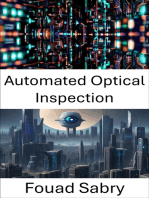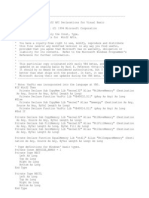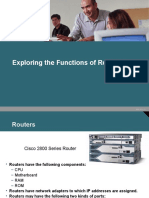PCB Lab
Uploaded by
Surya RPCB Lab
Uploaded by
Surya RJNTUA B.Tech.
R20 Regulations
JAWAHARLAL NEHRU TECHNOLOGICAL UNIVERSITY ANANTAPUR
B.Tech (ECE)– III-I Sem L T P C
1 0 2 2
(20A04509) PCB DESIGN AND PROTOTYPE DEVELOPMENT
(Skill Oriented Course – III)
Course Objectives:
This course will teach teams of students how to design and fabricate PCB for prototyping as well as in
Industrial Production environment. This will help students to innovate faster with electronics
technology.
Course Outcomes:
Understand a single layer and multilayer PCB
Create and fabricate a PCB
Evaluate and test a PCB
UNIT I
Fundamental of basic electronics: Component identification, Component symbols & their footprints,
understand schematic, Creating new PCB, Browsing footprints libraries, Setting up the PCB layers,
Design rule checking, Track width selection, Component selection, Routing and completion of the
design
UNIT II
Introduction to PCB: Definition and Need/Relevance of PCB, Background and History of PCB, Types
of PCB, Classes of PCB Design, Terminology in PCB Design, Different Electronic design automation
(EDA)tools and comparison.
UNIT III
PCB Design Process: PCB Design Flow, Placement and routing, Steps involved in layout design,
Artwork generation Methods - manual and CAD, General design factors for digital and analogue
circuits, Layout and Artwork making for Single-side, double-side and Multilayer Boards, Design for
manufacturability, Design-specification standards
Practice Exercises: Any twelve experiments are to be done
1. Practice following PCB Design steps
SchematicDesign:FamiliarizationoftheSchematicEditor,Schematiccreation,Annotation, Netlist
generation.
LayoutDesign:FamiliarizationofFootprintEditor,Mappingofcomponents,Creationof PCB layout
Schematic.
Create new schematic components.
Create new component footprints.
2. Regulator circuit using 7805
3. InvertingAmplifier or SummingAmplifier using op-amp
4. Full-wave Rectifier
5. Astable multivibrator using IC555
6. Monostable multivibrator using IC555
7. RCPhase-shiftorWein-bridgeOscillatorusingtransistor.
8. Full-Adder using half-adders.
9. 4-bit binary /MOD N counter using D-Flip flops.
10. One open-ended (analog/ digital/mixed circuit) experiments of similar nature andmagnitude to the
above are to be assigned by the teacher
(Student is expected to solve and execute/simulate independently).
11. Design an 8051 Development board
havingPowersectionconsistingofIC7805,capacitor,resistor,headers,LED.
12. Design an 8051 Development board having Serial communication section consisting of MAX 232,
Capacitors, DB9connector,Jumper, LEDs
13. Design an 8051 Development board having
Reset&Input/outputsectionsconsistingof89C51Microcontroller,ElectrolyticCapacitor,Resistor,Jumper,C
rystalOscillator,Capacitors
14. Fabricate a single-sided PCB, mount the components and assemble them in acabinet for any one of the
JNTUA B.Tech. R20 Regulations
circuits mentioned in the above exercises.
References:
1. Jon Varteresian, Fabricating Printed Circuit Boards, Newnes, 2002
2. R. Tummala, Fundamentals of Microsystems Packaging, McGraw-Hill 2001
3. C. Robertson. PCB Designer´s Reference. Prentice Hall, 2003
4. Open-source EDA Tool KiCad Tutorial: http://kicad-pcb.org/help/tutorials/ 13. PCB
Fabrication user guide page:
http://www.wikihow.com/Create-Printed-Circuit-Boards
http://www.siongboon.com/projects/2005-09-07_home_pcb_fabrication/
http://reprap.org/wiki/MakePCBInstructions#Making_PCBs_yourself
PCB Fabrication at home(video): https://www.youtube.com/watch?v=mv7Y0A9YeUc,
https://www.youtube.com/watch?v=imQTCW1yWkg
You might also like
- analog-and-digital-system-design-labbecl305-manual (1)No ratings yetanalog-and-digital-system-design-labbecl305-manual (1)52 pages
- Analog and Digital System Design Labbecl305 ManualNo ratings yetAnalog and Digital System Design Labbecl305 Manual50 pages
- 16 Easy Steps To Start PCB Circuit DesignNo ratings yet16 Easy Steps To Start PCB Circuit Design10 pages
- Ramesh Kumar Maurya (Roll No - 1742220034) Summer Training Report Auto Tools of Analysis and Desgin Ofintergrated CircuitNo ratings yetRamesh Kumar Maurya (Roll No - 1742220034) Summer Training Report Auto Tools of Analysis and Desgin Ofintergrated Circuit61 pages
- Gujarat Technological University: SUBJECT NAME: Design of AC Machines SUBJECT CODE: 2170909 B.E. 7 SemesterNo ratings yetGujarat Technological University: SUBJECT NAME: Design of AC Machines SUBJECT CODE: 2170909 B.E. 7 Semester3 pages
- ADE LAB UPDATED Manual-Draft 22 SCHEME - 23-24100% (1)ADE LAB UPDATED Manual-Draft 22 SCHEME - 23-2487 pages
- ABET - Design Project Summary Form SampleNo ratings yetABET - Design Project Summary Form Sample9 pages
- Electronic Engineering Drawing & WorkshopNo ratings yetElectronic Engineering Drawing & Workshop80 pages
- EC8691 Lesson Plan Microprocessor and Micro COntrollerNo ratings yetEC8691 Lesson Plan Microprocessor and Micro COntroller7 pages
- Advanced Hardware and PCB Design Masterclass 2022No ratings yetAdvanced Hardware and PCB Design Masterclass 20225 pages
- Ececc10 Electronic Design Workshop: Course Code Course Name Course StructureNo ratings yetEcecc10 Electronic Design Workshop: Course Code Course Name Course Structure3 pages
- Ec8661 - Vlsi Design Laboratory Manual 2022No ratings yetEc8661 - Vlsi Design Laboratory Manual 202261 pages
- Chhattisgarh Swami Vivekanand Technical University, BhilaiNo ratings yetChhattisgarh Swami Vivekanand Technical University, Bhilai22 pages
- Automated Optical Inspection: Advancements in Computer Vision TechnologyFrom EverandAutomated Optical Inspection: Advancements in Computer Vision TechnologyNo ratings yet
- 05 Query Processing and Optimization-TELUNo ratings yet05 Query Processing and Optimization-TELU56 pages
- Configuring External Storage For Archive Backup - TechNo ratings yetConfiguring External Storage For Archive Backup - Tech6 pages
- Temario Analisis y Diseño de Sistemas InformaticosNo ratings yetTemario Analisis y Diseño de Sistemas Informaticos2 pages
- Introduction: Databases and Database UsersNo ratings yetIntroduction: Databases and Database Users29 pages
- Microelectronics 2nd Edition Jerry C. Whitaker - Download the ebook in PDF with all chapters to read anytimeNo ratings yetMicroelectronics 2nd Edition Jerry C. Whitaker - Download the ebook in PDF with all chapters to read anytime57 pages
- Book Title:-Inorganic Chemistry For JEE (Advanced) : Part 1: OverviewNo ratings yetBook Title:-Inorganic Chemistry For JEE (Advanced) : Part 1: Overview3 pages
- Division of Electrical, Electronics, and Computer Sciences (EECS) Indian Institute of Science, BangaloreNo ratings yetDivision of Electrical, Electronics, and Computer Sciences (EECS) Indian Institute of Science, Bangalore2 pages
- Micro850 24-Point Programmable Controllers: Catalog NumbersNo ratings yetMicro850 24-Point Programmable Controllers: Catalog Numbers24 pages
- Medium Voltage Circuit Breaker Course 4.0 Student Manual Circuit Breaker CubicleNo ratings yetMedium Voltage Circuit Breaker Course 4.0 Student Manual Circuit Breaker Cubicle8 pages

























































































